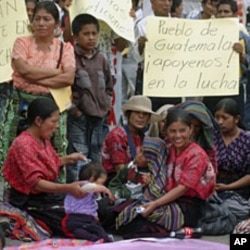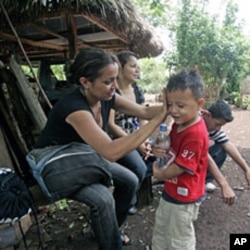Central America has made significant progress in recent years toward narrowing literacy gaps and empowering women. More women are coming to positions in power in places like Costa Rica and Guatemala. But the overall situation for women remains dismal in a region designated by the United Nations in 2009 as the most violent in the world.
The region’s homicide rates have escalated in the past 15 years, according to Manuel Orozco, Director for Central America and Director of the Migration and Development Program at Inter-American Dialogue. He says current homicide rates in most of the region have been occurring at the rate of 10-15 a day since the late 1990s. Out of that tally, the number of murdered women has nearly tripled in almost every country, especially El Salvador, Guatemala, and Honduras.
Central American Gender Indicators
Orozco attributes the trend to youth crime, violent transnational gangs, and sexual violence, all of which increasingly affect women, particularly those related to gang members who quit, or those who have joined gangs. But that kind of violence also spills over to affect ordinary people like Rosa Leyva, a mother and homemaker in Mexico who said in an email interview that she and her mother always live with the “fear that our sons and husbands … leave our home and not return.”
El Salvador has had the world’s highest number of female homicides for the last few years, according to Jocelyn Viterna, a Harvard University Associate Professor of Sociology.
“There has been … sort of a machismo understanding in El Salvador that men have the right to control what happens in their house,” said Viterna. “And that includes the right to keep women in line, perhaps by violence if necessary. And there is a lack of legal and judicial will to change that situation.”
Despite recent legal initiatives to address the problem, Viterna says gang violence in El Salvador is a bigger problem and judges are unlikely to punish domestic abusers in the first place.
A recent bill pushed by female legislators calls for the creation of a fund to support victims of domestic abuse. Viterna says the fund would create a space for women to escape their aggressors.
“But my concern is that the fund is supposed to be paid for by the aggressors when they go to court," Viterna cautioned. "So if the judicial system … continues to pardon men for domestic violence … it might take a very, very long time to develop.”
These types of violence stem from the culture of the region and perceptions of authority, says Orozco. He argues that the region's social structure gave precedence to males as heads of the church, the country, and the family.
“So we call it the Trinity – il padre de la iglesia, el padre la patria, e il padre de la familia. The Three Ps basically created a condition by which authority was male-gendered, as well as concentrated in authority,” said Orozco. “This ... has been inherited as part of the popular and political culturing of our societies.”
Orozco says the region is still "prisoner of many notions of gender differentiation, where women are still perceived by some as being below.”He cites Guatemala, Honduras, Nicaragua, and Costa Rica as examples of places where women, particularly ethnic women such as Mayans and Afro-Caribbean women, are discriminated against on multiple levels of gender, race, and ethnicity.
Jennifer Catino of The Population Council’s Poverty, Gender, and Youth Program in New York says ethnic minorities across the region face social, economic and political marginalization stemming from histories of social exclusion and discrimination. They bear what Catino describes as a “triple burden” of being poor, living in remote areas, and experiencing ethnic and gender discrimination.
Social and economic disparities characterize the region as a whole, says Catino. “And while national averages tend to look somewhat better than other regions, when you break down indicators like literacy, for example, and look at them by poverty level, by urban-rural residence, by ethnicity, and perhaps most strikingly by sex, you see massive inequalities,” said Catino.
While countries like Guatemala, which only emerged from a bloody conflict 20 years ago, continue to lag behind, most of the region has made significant progress toward narrowing literacy gaps. More women are able to attend school today and study fields previously dominated by men. But decades of exclusion have left women unequipped for today's competitive labor market, as The Population Council's Catino points out.
"So opportunities for women are much reduced because they’re not set up from a very young age to be able to be competitive and to participate,” Catino said.
Women like Claudia Gonzales, a native of El Salvador, simply left the country to find better opportunities in the United States. She says finding a job in El Salvador is difficult, especially for women under 20 or over 60 years of age. She is one of millions of Central American migrants enticed by the promise of a better life in the United States and Europe. And according to Orozco's research, there is a decade-long pattern where women, and particularly women with tertiary education, are more likely than men to migrate from the region.
Heidy Sandoval, for example, immigrated to the United States to join her mother in the Washington, D.C. area, where she runs the register at a local restaurant. Finding college too expensive, she supports her mother and sends money back home to her two sisters to help pay for education and bills.
Like Heidi, Vilma* left El Salvador to find a better life for her family in the United States. Her cleaning service in Norcross, Georgia, helps her support her family in the U.S. and allows her to send money and clothes to relatives in El Salvador to help them with schooling and every day needs.
Beatriz*, who works at a restaurant in Manassas Virginia, had a job in her native Mexico that couldn't pay her medical bills after giving birth and getting sick. She came to the United States to find a better paying job - one that now allows her to send money back to Mexico to help support her parents.
About 2.5 million migrant women - about half of Central America's migrants - sent about $13 billion in remittances back to Central America in 2010, according to Inter-American Dialogue’s Orozco. Two-thirds of the recipients were women heads of households.
“And that is having an effect in empowering women and allowing women the opportunity to manage their own resources and deciding how to invest those resources,” said Orozco. “But the homemakers are increasing their independence, are being able to manage their funds more independently than they used to be when they were directly dependent on the husband’s salary.”
Central America's women have, in fact, taken the initiative to improve their lot by becoming increasingly visible in community work and non-governmental organizations - a move that is slowly leading women to greater positions of leadership. According to Orozco, women are increasingly active in NGOs across Central America, accounting for more than 40 percent of executive directors.
"There are far many more NGOs than political parties. And their influence in the social agenda and the political sphere is significantly important," said Orozco.
*Some names have been withheld to protect the identity of undocumented migrants.


